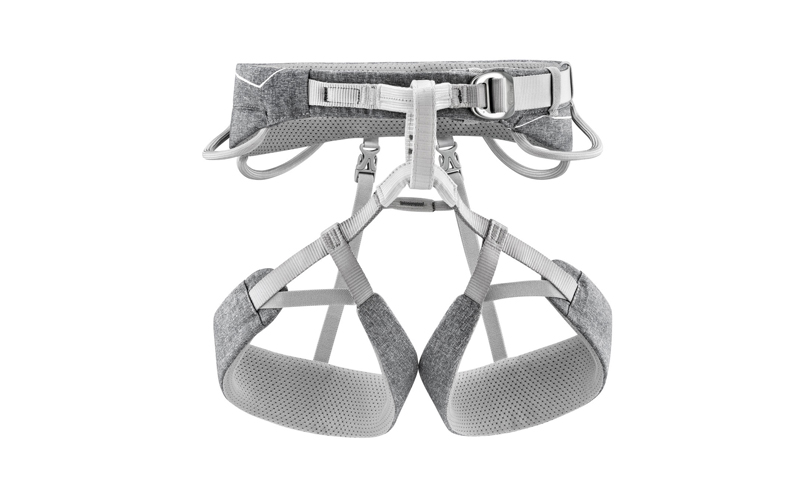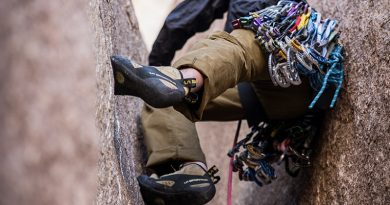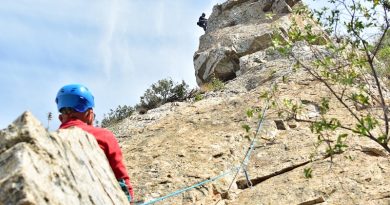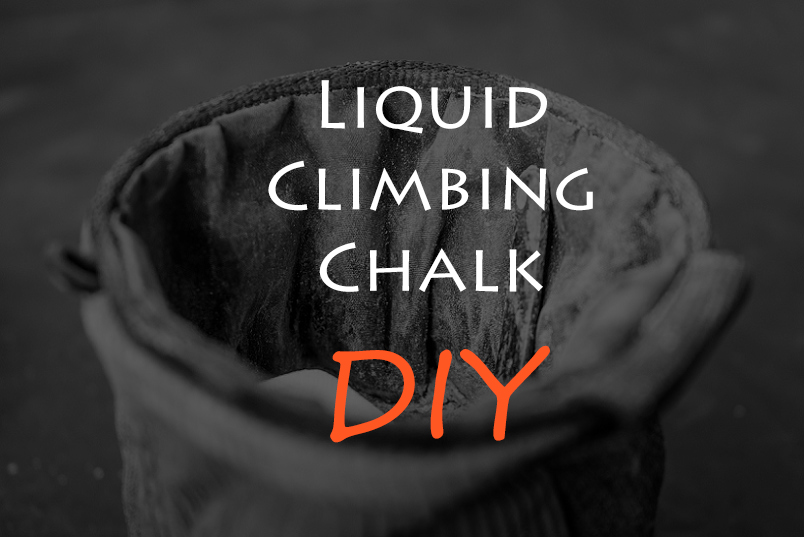Ever wondered about rock climbing chalk?
Then this rock climbing FAQ is the place for you! Here, you’ll find answers to all your chalk questions.
Does Chalk Really Help Climbing?
Absolutely! Your body produces tons of sweat, especially when you exercise. If you don’t take the proper precautions, this sweat can stick to your skin and make your body slippery. You don’t want to be halfway up a rock wall when your hand is suddenly too wet to grab onto the next hold.
Climbers use chalk to dry sweat, oil, and other moistures that may come into contact with their skin. This prevents the pooling of excess moisture and ensures a safer, more stable climb.
Does Chalk Improve Grip?
Yes. In fact, increasing grip is the main purpose of climbing chalk. Chalk serves to protect your skin from unnecessary moisture, ensuring that you have greater friction and traction to make that next hold. Climbers who forgo chalk often find themselves experiencing greater difficulties scaling walls. You won’t find it easy holding onto a rock with drenched hands.
Still, climbers should avoid using too much chalk. Research indicates that excessive use actually decreases the amount of friction between your hands and your hold. This reduces grip strength and makes it harder for you to climb safely. The reasoning is actually quite simple. When you apply too much chalk, you create a lubricating layer between your skin and the rock wall. This means that applying too much chalk can be just as bad as not applying chalk at all. For this reason, make sure that you are following suggested guidelines when you chalk up for each and every climb.
Is Climbing Chalk Bad for You?
If you’re an avid climber, you’ve probably gotten worried about chalk dust a time or two. After all, it can be quite alarming to see all the dust flying around you—especially in crowded gyms.
But is this dust really bad for you? Let’s see how chalk dust impacts different parts of your body.
- Hands
Chalk dust won’t harm your hands, per se, but it can make them dry. You want to avoid using too much chalk when you climb, as this can increase your risk of dry hands. Many climbers complain of excessively dry or cracked hands after repeated use of climbing chalk. For this reason, make sure to moisturize well once you get home to eliminate the effects of dust buildup.
- When You Breathe It
So how about when you breathe those mountains of dust? It turns out that’s pretty okay, too—in moderation While you never want to expose yourself to any fine dust for extended periods of time, it’s likely that you won’t come into contact with a harmful amount of chalk dust while climbing. This is especially true if you use a chalk ball or other dust-limiting option.
- Is Sniffing Chalk Bad?
Climbers breathe chalk like gardeners breathe flowers. It’s simply part of the process. And while breathing too much fine dust damages the body’s respiratory system in the long term, your rock climbing trips likely won’t put you in harm’s way.
Of course, you still want to minimize your exposure to chalk dust. You don’t want to whiff your chalk or breathe it in any more than you have to. Any prolonged exposure to fine dust can be carcinogenic, so you may want to go with chalk balls or powdered chalk if it makes you feel better.
How Do You Use Chalk Socks?
Perhaps you’ve seen those climbers with their little chalk sacks, but you don’t know quite how to use them. Take heart—it’s easier than you may think. Simply fill your sock with enough chalk to last you for several trips. You want to make sure that you leave space at the top of your sock so that your chalk doesn’t spill out in transport.
Once you have filled your sock, it’s ready to go. Take it with you to your climbing destination and chalk up your hands (and possibly arms) for your next climb. You want to make sure that you aren’t using too much chalk. Instead, focus on applying a thick (but fine) coat to your hands and arms. This will allow you to make the perfect grip. If your hands look like you were rolling them around in flour, you’ve definitely used too much chalk. Keep in mind that while your chalk sock may not be appropriate for every gym, it’s the ideal tool for outdoor rock climbing.
Do You Need a Chalk Ball?
It depends. Whether or not you need a chalk ball largely rests on what type of climbing you wish to do. For example, are you climbing in the gym, or are you taking your adventures outside for a little extra fun?
Many gyms prefer and even require that their users use chalk balls. This is because these balls—which consist of mesh sacks filled with powdered chalk—help control the amount of chalk that’s being released in the air. When a gym full of people are chalking themselves at the same time, it gets pretty crazy. Chalk balls help cut down on chalk “pollution” and make a more enjoyable gym experience for all involved.
Still, many climbers find it difficult to chalk up for outside climbs when using a chalk ball. For this reason, it’s recommended that you use traditional chalk if you plan on climbing outdoors.
Why Do You Use Chalk for Bouldering?
Bouldering exerts your body and works your muscles. In fact, research indicates that bouldering is one of the best exercises for working various muscle groups in your upper body. It may come as no surprise, then, that the sport causes you to sweat—and a lot. In order to be safe while climbing, you’ll want to use chalk to keep your hands and arms dry.
Think about it this way: wet hands on a rock wall mean danger. By using chalk, climbers keep their hands dry and ensure better grip during their bouldering session. Even compared to rock climbing, bouldering underscores the need for the climber to remain moisture-free and dry. You want your skin to be as dry as possible as you climb so that you can produce enough friction for a safe climb.
Is Climbing Chalk Bad for the Environment?
Rock climbing gets messy. At times, there is so much chalk that it can feel like you are working through fog. Chalk handprints dot the crag you are climbing, and chalk dust settles around the rocks below you. But does this mean that climbing chalk is bad for the environment?
Fortunately, the magnesium carbonate that makes up your climbing chalk does little to harm the environment. In fact, your climbing chalk is as harmless as sand. This makes sense considering the fact that magnesium carbonate is not a manmade substance but can be found in nature itself. This doesn’t mean, however, that there’s no environmental downside to your climbing chalk. In fact, many rock climbing areas strictly forbid certain types of climbing chalk. That’s why “eco-chalk,” a climbing chalk variety that works against “visual pollution” of the environment has become a popular option in recent years.
What Kind of Chalk is Used for Climbing?
Rock climbing and bouldering chalk differs significantly from standard chalk that is used to write with. Specifically, climbing chalk consists of a different chemical structure that allows it to be used as a drying agent and grip enhancer.
While most climbing chalk is formed from magnesium carbonate, there exist several forms of chalk that are available to climbers. Each form has its own purpose and benefits depending on a particular situation. Climbers generally categorize chalk into the following areas:
- Chalk Block—A chalk block is exactly what it sounds like—a block of chalk. While chalk blocks tend to be less expensive than other forms of climbing chalk, they require the climber to crumble them up themselves and place them into a chalk bag.
- Powdered Chalk—Powdered chalk consists of fine loose particles that can be dumped into chalk bags or socks and used to enhance grip during climbing. This type of chalk is one of the most popular styles of climbing chalk, despite being banned in many rock climbing gyms.
- Liquid Chalk—Liquid chalk applies as a liquid but quickly dries into a chalky substance on the skin. This type of chalk emits no powders, making it a great option for crowded areas and for climbers attempting to avoid chalk fog.
How Expensive is Climbing Chalk?
The price of climbing chalk varies by vendor and by chalk type. In general, powdered chalk will run you anywhere from $3-$10. Liquid chalk options charge you even more, with several brands averaging around $20 a tube. Remember that this isn’t the only expense you should keep in mind as you prepare for your next climbing session. Dedicated climbers may also want to purchase chalk bags or socks to bring with them to their climbing destination. On average, chalk bags price around $10. This means that you’ll likely spend around $20 for a chalk bag and powdered chalk.
You may also wish to purchase a chalk ball, particularly if you plan on doing most of your climbing at the gym. The price of chalk balls largely depends on whether or not you purchase a refillable option. Refillable options run around $10-$15 a pop, making them an affordable option for the frequent climber.
How Do Chalk Bags Work?
Chalk bags offer climbers for a thorough chalk application that’s great for long or outside climbs. These bags hold a well of chalk that climbers can dip their hands in to and coat for their upcoming climbs. Unlike chalk balls, chalk bags can be quite messy. In fact, many gyms outright ban these bags, as some climbers tend to get carried away with chalk application.
Many climbers prefer chalk bags because they provide for a more thorough and long-lasting chalk application. While chalk bags offer benefits to climbers, they are more prone to spills. Depending on your climb, this may be a worthy trade-off. Still, in those situations where a thick chalk application is not needed, climbers may benefit from alternative chalk sources. These bags come in three sizes: small, standard (for heavier rock climbing), and bucket size (designed for group bouldering expeditions).
What is the Chemical Composition of Climbing Chalk?
Nearly all climbing chalk you will use is made from magnesium carbonate—MgCO3. Magnesium carbonate occurs naturally in the environment and helps to reduce moisture when applied to the skin. What’s more, as a solution that’s insoluble in water, it won’t break down like traditional chalk when it comes into contact with moisture.
Because of its chemical composition, MgCO3 chalk benefits athletes in a variety of sports. From rock climbing to gymnastics, this chalk serves to protect against the pooling of excess moisture and allow athletes to gain a better grip on their surroundings. In rock climbing, the proper amount of chalk can be the difference between a safe and dangerous climb—making magnesium carbonate crucial to a positive rock climbing experience.
Is Climbing Chalk Different from Weight Lifting Chalk?
Nope! Both climbing chalk and weight lifting chalk share the same MgCO3 formula. This means that you can use that weight lifting chalk for your next climb if you’ve got some stored away. In both scenarios, the chalk works to reduce sweat and other moisture and enhance grip (either on rock or metal).
Though climbing and weight lifting chalk share the same chemical formula, you want to keep in mind that different quantities may be needed for each sport. In particular, outdoor rock climbing warrants a greater deal of chalk. Make sure to read up on ideal chalking guidelines before using your weight lifting chalk in rock climbing. In general, however, chalk balls are ideal for indoor rock climbing and weight lifting due to the relatively small amount of powder they release into the air.






